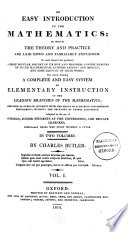 | Alexander Malcolm - 1730 - 702 páginas
...fliewn that</x«— -i=s/— -л. and dividing equally by » — i, it is</= *. Ж *^~ I 2. For ti multiply the Sum of the Extremes by the Number of Terms, and take half of the Produo, it's the Sum : Thus *= *"HX*. E*a*,fk: - = 3./=iy.» = 7. then is /==6, —... | |
 | Charles Vyse - 1785 - 350 páginas
...continuing by the Increafc of 2 to 100 Places? PROPOSITION VII. The firft Term, common Difference, and Number of Terms being given, to find the Sum of all the Series. RULE. From tli? Product of the Number of Terms in the common Difference, fubtra'cl: the common... | |
 | 1801 - 446 páginas
...sum of all the terms. . , PROBLEM I. , 1'te frit term, the last term, and the number of terms behtg given, to find the sum of all the terms. RULE.* Multiply...and half the product will be the answer. EXAMPLES. * Suppose another series of the same kind with the given one be placed under it in an inverse order... | |
 | Charles Vyse - 1806 - 342 páginas
...continuing by the Increase of 2 to 100 Places? PROPOSITION VII. The first Term, common Difference, and Number of Terms being given, to find the Sum of all the Series. RULE. From the Product of the Number of Terms in tl# common Difference, subtract the common... | |
 | Nicolas Pike - 1808 - 470 páginas
...term, the last term, and the number of terms being given, tojind the sum of all the terms. RuLE.f — Multiply the sum of the extremes by the number of terms, and half the producl will be the answer. EXAMPLES. • The difference of the firft and laft terms evidently (hews... | |
 | Nicolas Pike - 1809 - 312 páginas
...term, and the number of terms being gi-oent to fnd the fum of all ths terms, RULE. Multiply the fum of the extremes by the number of terms, and half the product will be the anfwer. EXAMPLES. i. The extremes of an arithmetical feries are 3 and 39, and the number of terms i... | |
 | 1811 - 210 páginas
...difference, and ,to the product add the first teim, the sum is the last term. 2. Multiply the sum of the two extremes by the number of terms, and half the product will be the sum qf all the terms. f EXAMPLES. •I. The first term 01 a certain series in anumicucoi progression... | |
 | Samuel Webber - 1812 - 260 páginas
...terms. 4. The common difference. 5. The sum of all the terms. PR0BLEM 1. Tke first term, the last term, and the number of terms being given, to find the sum...Multiply the sum of the extremes by the number of terms, ami half the product will be die vinswer. EXAMPLES. 1. The first term of an Arithmetical Progression... | |
 | Jeremiah Joyce - 1812 - 274 páginas
...may be easily found. I. When the first term a, and the last .term z, and th« number of terms n, are given, to find the sum of all the terms, *. RULE. Multiply the sum of the extremes by the number ofte/mi, and divide by 2, the quotient is the ansu-er: or n a. + z X — = s. Ex. i . What is the sum... | |
 | Charles Butler - 1814 - 540 páginas
...be found, as is shewn by the rules and examples following. 289. The least term, the greatest term, and the number of terms, being given, to find the sum of all the terms. RULE. Add the least and greatest terms together, multiply the sum by half the number of terms, and the product... | |
| |